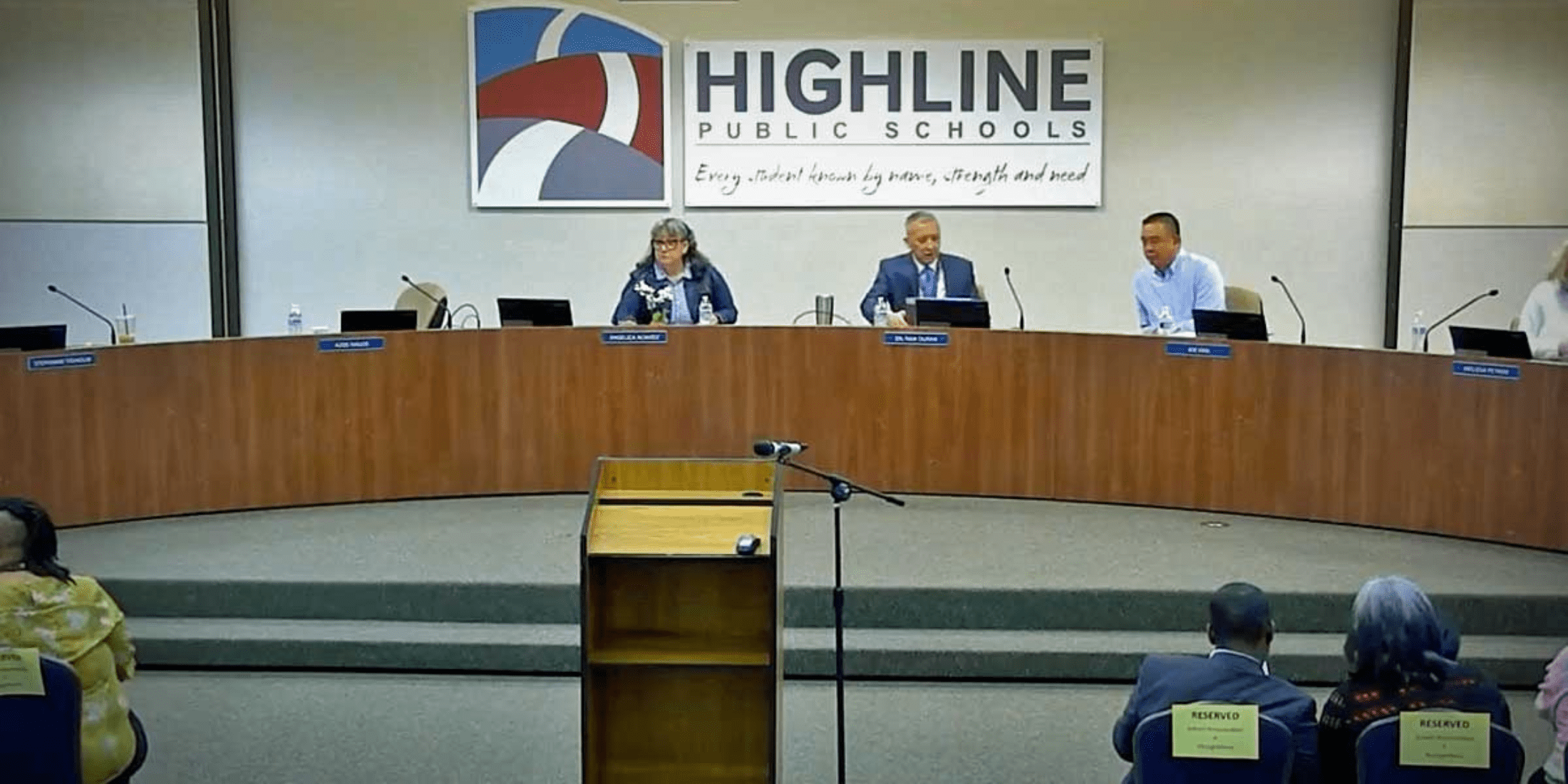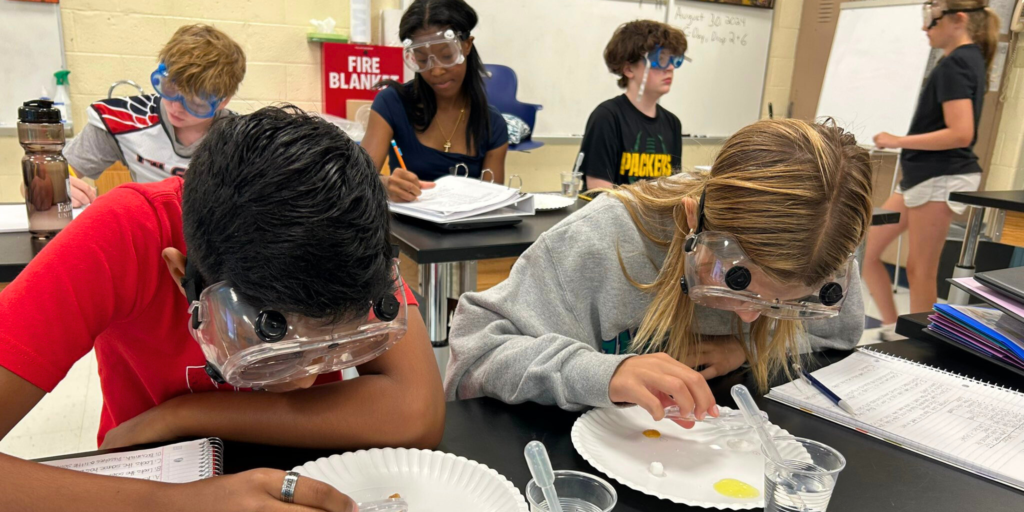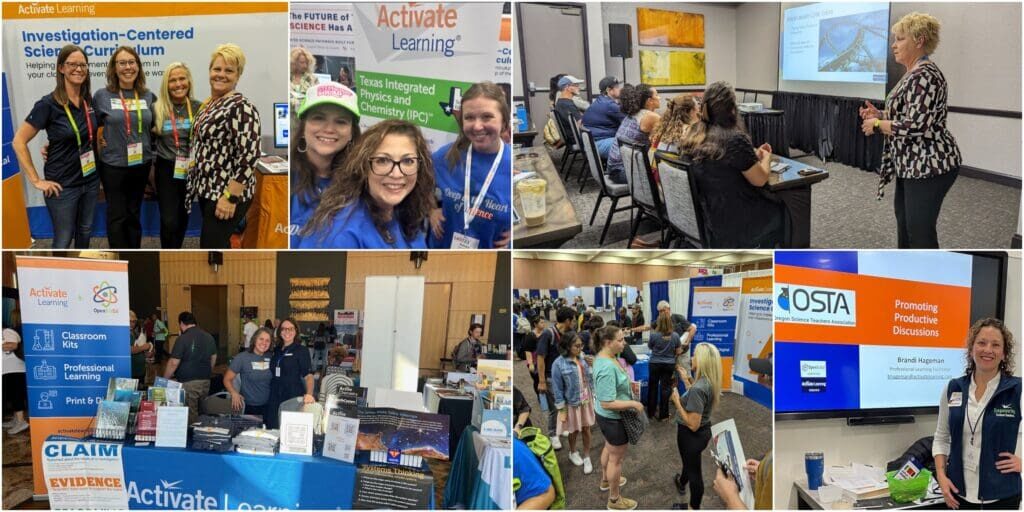How to Prepare High School Students for the Future of Biology-Driven Industries and Careers
How to Prepare High School Students for the Future of Biology-Driven Industries and Careers
![OpenSciEd Biology High School Students [New Mission High School seniors (from left) Darareaksmey Chhim, Mario Fils, and Dorian Planto present their innovative idea for plastic-consuming bacteria at the Synthetic Biology Shark Tank Competition held at BU's Biological Design Center on April 26, 2024. CREDIT: Boston University]](https://activatelearning.com/wp-content/uploads/2024/05/OpenSciEd-Biology-High-School-Students.png)
Quick Take: Discover how emerging biology fields, such as biotech, biomedicine, and biomanufacturing, are transforming industries and the essential role of innovative, NGSS-aligned curricula like OpenSciEd Biology, available through Activate Learning, in preparing high school students to thrive in a bio-driven future. Learn how educators can engage students in learning about emerging biologies with hands-on science investigations, interdisciplinary 3D learning, and real-world research opportunities.🧬🔬
Dive in to the world of emerging biologies!
- Intro: Preparing High School Students for the Future [read more]
- What are Emerging Biologies and How Are They Transforming Industries? [read more]
- Learning High School Biology: Longstanding Challenges and New Solutions [read more]
- Incorporating Emerging Biologies into the Classroom [read more]
- Conclusion: The Future of Biology is Here! [read more]
Preparing High School Students for the Future of Biology-Driven Industries and Careers
Imagine a world where the boundaries of traditional biology are being pushed to the limits, giving rise to groundbreaking advancements that will revolutionize industries and create new career opportunities. Welcome to the era of emerging biologies, where fields like biotech, biomedicine, biomaterials, bioenergy, biomanufacturing, and biomimicry are taking center stage and changing society in profound and unprecedented ways.
The impact of these advancements is far-reaching, with the potential to address major global challenges and create new opportunities across various sectors – from healthcare and personalized medicine to sustainable materials and renewable energy. When defining Microsoft's vision for the development and implementation of Artificial Intelligence (AI), CEO Satya Nadella explained with excitement, “Our goal is to compress the next 250 years of chemistry and materials science progress into the next 25 years!”
Mr. Nadella’s visionary statement underscores the rapid pace of innovation happening in the emerging sciences and its transformative potential to reshape our world in the blink of an eye. As new biology fields emerge and evolve at an unprecedented rate, it becomes increasingly clear that the future of many industries will be driven by biology that is powered by AI. Students will enter not only traditional biology fields, but also those traditionally unrelated to biology, which are now being driven by biological advancements.
This raises crucial questions for educators: How can we effectively prepare students for biology-driven industries and careers of tomorrow, and empower them to embrace the spirit of fast-paced innovation?
To succeed in this new landscape, students (especially high school students at the precipice of entering this new biological workforce) will need a deep understanding of biological principles and the ability to work across disciplines and harness the power of emerging technologies. It’s important that they be introduced to the exciting world of emerging biologies sooner than later and that they're equipped with the skills and knowledge needed to thrive in this new biological era.
We recently explored the future of high school STEM education in a 3-part blog series. In this post, we’ll touch on the rise of emerging biologies, their transformative potential across industries, and resources and tools (including innovative curricula like OpenSciEd) that can help educators prepare high school students for unprecedented change and opportunities in biology.
What are Emerging Biologies and How Are They Transforming Industries?

Emerging biologies, a term that encapsulates the rapidly evolving and interdisciplinary fields pushing the boundaries of traditional biology, is transforming our understanding of life sciences and their potential applications. The scope of emerging biologies is vast and growing by the minute, encompassing areas such as:
- Quantum Biology: Applying quantum computing to solve biologically relevant problems, such as understanding protein evolution, exponentially faster than classical computers.
- Bioinformatics: Applying computational tools and databases to address biological challenges, such as identifying gene and protein structure prediction.
- Biomanufacturing: Using biological systems to produce complex molecules, materials, and products, revolutionizing industries such as pharmaceuticals, chemicals, and textiles.
- Synthetic Biology: Designing and constructing new biological parts, devices, and systems, as well as modifying existing ones, combining biology with engineering principles for applications in biofuels, therapeutics, and materials.
- Bioremediation: Using microorganisms to clean up environmental pollutants, such as oil spills or toxic waste, by breaking down the contaminants into less harmful substances.
- Analytical Biology: An emerging discipline that blends various research fields at the intersection of physics, biology, and chemistry to provide a holistic view of biological phenomena, attracting increasing interest and generating many innovative ideas.
These fields are poised to transform healthcare, agriculture, energy, materials science, and environmental sustainability, among others. But the advancements in emerging biologies are not just theoretical; they’re already making significant strides in revolutionizing various industries and creating new opportunities for growth and innovation in many industries.
In healthcare, emerging biologies are paving the way for personalized medicine, where treatments are tailored to an individual's genetic profile, leading to more effective and targeted therapies. Regenerative medicine, another product of these advancements, aims to repair or replace damaged tissues and organs using stem cells and tissue engineering techniques.
Sustainable materials and manufacturing are benefiting from advancements in biomaterials. Bioplastics, derived from renewable resources like plants and microorganisms, are being developed as eco-friendly alternatives to traditional petroleum-based plastics. These biodegradable materials have the potential to significantly reduce the environmental impact of manufacturing and waste disposal.
The field of bioenergy is harnessing the power of living organisms to produce sustainable and renewable energy sources. Algae-based biofuels, for example, are being explored as a cleaner alternative to fossil fuels, with the potential to reduce greenhouse gas emissions and combat climate change.
Emerging biologies are also inspiring innovative solutions to a wide range of challenges by emulating nature's designs and strategies. Biomimicry, the practice of learning from and imitating natural systems, is being applied to create energy-efficient buildings, water-purification systems, and even self-healing materials.
At the forefront of emerging biologies is the concept of "biological machines" (synthetic biology) - engineered living organisms designed to perform specific functions. These tiny, living machines blur the line between biology and technology. One example of biological machines is the use of genetically engineered microorganisms to produce pharmaceuticals, such as insulin for diabetes treatment or vaccines for infectious diseases. By programming these organisms to synthesize specific compounds, researchers can create more efficient and cost-effective production processes.
By harnessing the power of living systems and applying cutting-edge technologies, emerging biologies are unlocking new frontiers in innovation and creating opportunities for economic growth and societal advancement previously unimaginable. Our future is being shaped by the convergence of biology, engineering, and technology.
Learning High School Biology: Longstanding Challenges and New Solutions
To succeed in new bio-driven fields, students will need a deep understanding of biological concepts and the ability to work across disciplines, incorporating knowledge from engineering, technology, and other areas. They must also learn to stay abreast of accelerating innovations and embrace change.
Educators today will need to focus on developing the skills and mindsets that will enable students to thrive in biology-driven industries and careers. This includes fostering critical thinking, problem-solving, collaboration, and adaptability, as well as nurturing a passion for lifelong learning. With the boundaries between traditional disciplines becoming increasingly blurred, it’s important that students learn to think beyond the confines of a single subject and embrace the interdisciplinary nature of emerging biologies.
The Challenges
A recent research study in the Journal of Biology Education (Analysis of Student Difficulties in Learning Biology), indicates that high school students face a range of internal and external challenges when learning biology. Internal factors include difficulty understanding scientific language, lack of interest or motivation, trouble focusing, and a perceived lack of background knowledge. External factors encompass ineffective teaching methods, insufficient family support, and outdated learning strategies. Additionally, a curriculum that is not aligned with standards and lacks integration of other STEM subjects within the biology syllabus hinders students' competency in cross-cutting concepts and inquiry-based science.
Teachers also face numerous obstacles. A study from the independent non-profit EdReports highlights significant shortcomings in high school science curricula and instructional materials. An astonishing 92% of high school science teachers report lacking comprehensive instructional materials that align with academic standards. Consequently, most educators cobble together fragmented resources independently due to the absence of a cohesive, standards-based curriculum.
High school biology teachers urgently need resources, tools, and professional learning support to consistently engage students and provide hands-on experience with real-world problems and scientific discoveries.
The Solution: OpenSciEd High School Science Curriculum

Success of new OpenSciEd biology curriculum highlighted at Highline School Board meeting, May 3 2024.
“Based on our thorough review of the program… as well as data from piloting two of the highest quality programs, the committee is recommending adoption of the OpenSciEd biology program, which scored highly throughout all phases of the review and pilot process!” -- Nicole Flynn (Highline School District)
Traditional textbook-based approaches, where students simply learn science rather than doing science are no longer sufficient. These materials often fail to capture the dynamic and interdisciplinary nature of emerging biologies. OpenSciEd is an innovative, open-source, high school science curriculum aligned with the Next Generation Science Standards (NGSS) that emphasizes investigative science research, the interconnectedness of subjects through 3-dimensional learning, and real-world applications (aligning with the multifaceted demands of emerging science). 
Jodi Bahr, a Professional Learning Facilitator at Activate Learning and a high school biology teacher, shares insights into the empowerment OpenSciEd brings to students: "OpenSciEd allows teachers to implement best practices in the classroom, giving all students the opportunity to learn chemistry, physics, biology, and earth science."
Aligning with NGSS is key to OpenSciEd's ability to engage all students, as it "enables students to build background knowledge and make connections across various ecosystems and real-world case studies," explains Jodi.
With OpenSciEd, students figure out science rather than memorizing information, developing a deeper understanding of biological concepts and their relevance to the world around them. Students respond to this deeper learning with immediate enthusiasm.
The resounding success of OpenSciEd's pilot program in Washington's Highline School District, with the support of Activate Learning, testifies to the curriculum's potential to transform biology education and motivate students. Pilot program students, who had requested more relevant learning, reported increased engagement and empowerment, while teachers praised the curriculum's ease of use and ability to foster critical thinking and problem-solving skills.
During the district's board meeting, Nicole Flynn, Secondary Science Specialist, noted that "an average of about 80% of students shared that they made contributions to the lessons and felt their ideas were respected."
OpenSciEd accomplishes this by building background knowledge and making connections across ecosystems and case studies, preparing students for the interdisciplinary nature of emerging biologies. The curriculum's emphasis on real-world applications ensures students learn abstract concepts and develop relevant skills and mindsets needed to tackle complex challenges. Most importantly, OpenSciEd empowers students to drive their learning journey, equipping them with opportunities to innovate in bio-driven fields upon entering the workforce.
Jodi, in her role as a Certified OpenSciEd PL Facilitator, witnesses the transformation in students and teachers as they embrace this new way of teaching and learning.
"OpenSciEd offers many opportunities for students to 'notice and wonder' and share ideas with peers through small group and whole class discussions," she explains. This is a game-changer in science education. “OpenSciEd helps students become independent thinkers and support their claims with evidence. All kids feel like they have a voice in the science classroom,” says Jodi.
OpenSciEd weaves collaborative and creative problem-solving throughout every unit and exercise. For example, in OpenSciEd’s Zombie Fires unit, students begin by exploring fire, which leads them to study decomposers, cellular respiration, and ultimately photosynthesis.
They conduct investigations on fuel and carbon dioxide, measure temperature changes due to increasing carbon dioxide, and study yeast to determine the optimal temperature for decomposers. This unit covers data collection (math), earth science, biology, and integrates concepts from the hydrosphere, atmosphere, geosphere, and biosphere.
These engaging, thought-provoking learning experiences that encourage social interaction are how and why students in Highline School District responded so favorably to OpenSciEd Biology.
Incorporating Emerging Biologies into the Classroom
OpenSciEd's Biology units offer numerous opportunities for teachers to incorporate emerging biologies into their teaching. For example, the Ecosystems Interactions & Dynamics unit explores the complex relationships within ecosystems, providing a foundation for understanding the principles behind biomanufacturing and biomimicry.
Similarly, the Natural Selection & Evolution of Populations unit delves into the mechanisms of evolution and adaptation, which are crucial concepts for fields like synthetic biology and bioengineering. Students gain insights into the potential of engineering biological systems for specific purposes by studying how populations evolve in response to environmental pressures.
Educators can leverage the practical insights and resources provided by OpenSciEd to effectively incorporate emerging biology into the classroom. From engaging investigative research activities to real-world case studies and expert insights, the curriculum offers a wealth of materials that can be adapted to highlight the connections between biology and emerging fields.
By showcasing the exciting applications of biology in fields like personalized medicine, sustainable materials, and bioenergy, educators can inspire students to pursue careers in biology-driven industries. For example, OpenSciEd includes 3–5-minute interviews with expert biologists in the Serengeti National Park.
Educators can also encourage students to embrace emerging biology fields by participating in extracurricular research programs and competitions such as USA BIOlympiad, Plant the Moon, The BioGENEius Challenge, Synthetic Biology Shark Tank, and The Regeneron Talent Search.
Keeping students engaged in scientific research can be achieved by incorporating real-world studies into classroom learning. Science in the Classroom, a project by the American Association for the Advancement of Science, offers a collection of freely available annotated research papers from Science journals. This resource helps educators and advanced high school students understand scientific literature through annotations and accompanying teaching materials.
Through 3-dimensional, NGSS-aligned curricula like OpenSciEd and exposure to cutting-edge research and innovative technologies, students can envision themselves as future leaders and innovators in rapidly evolving bio-driven fields.
Conclusion: The Future of Biology is Here!
As we stand on the brink of a new era in biology, the future is quickly being shaped by the innovations and discoveries made in emerging fields like biotech, biomedicine, and biomanufacturing.
The OpenSciEd high school science curriculum, now fully available for biology through Activate Learning, represents a powerful tool for educators seeking to rise to this challenge. By emphasizing the interconnectedness of subjects, real-world applications, and developing critical thinking and problem-solving skills, OpenSciEd equips high school students preparing to enter the workforce with the knowledge and mindsets they need to succeed in biology-driven industries and careers.
But the transformative potential of emerging biologies extends far beyond the realm of education. These fields hold the key to solving some of the most pressing challenges facing our world. It’s essential that we create a sense of excitement and urgency around the study of emerging biologies, inspiring a new generation of scientists, innovators, and changemakers.
Preparing today’s students to solve problems and thrive in this rapidly evolving landscape is not just an educational imperative; it is a critical investment in the future of our society and planet. The future of biology is here, and it is filled with endless possibilities and opportunities for all students!
* * * * * *




